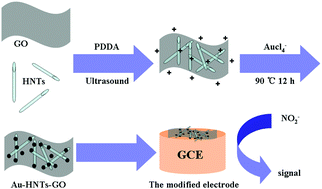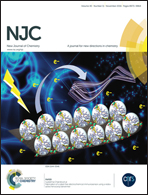Synthesis of Au nanoparticles dispersed on halloysite nanotubes–reduced graphene oxide nanosheets and their application for electrochemical sensing of nitrites†
Abstract
Nanocomposites of Au nanoparticles supported on natural halloysite nanotubes and graphene oxide (HNTs–GO) were prepared and used for fabricating a novel nonenzymatic nitrite sensor. The structure and morphology of the Au–HNTs–GO nanohybrid film were characterized by X-ray diffraction, energy-dispersive X-ray spectroscopy (EDS), scanning electron microscopy (SEM) and transmission electron microscopy (TEM). Electrochemical investigations were carried out by cyclic voltammetry and amperometry. The results indicate that the sensor possesses an excellent performance toward nitrites with two linear ranges: one from 0.1 μM to 6.33 mM with a correlation coefficient of 0.9839 and a sensitivity of 23.1 μA m(mol L−1)−1 cm−2, and another from 6.33 mM to 61.9 mM with a correlation coefficient of 0.9976 and a sensitivity of 86.5 μA m(mol L−1)−1 cm−2. The detection limit of the sensor was 0.03 μM with a signal-to-noise ratio of 3. In addition, the sensor could be applied in practical analysis and exhibits good reproducibility, long-term stability and anti-interference.


 Please wait while we load your content...
Please wait while we load your content...